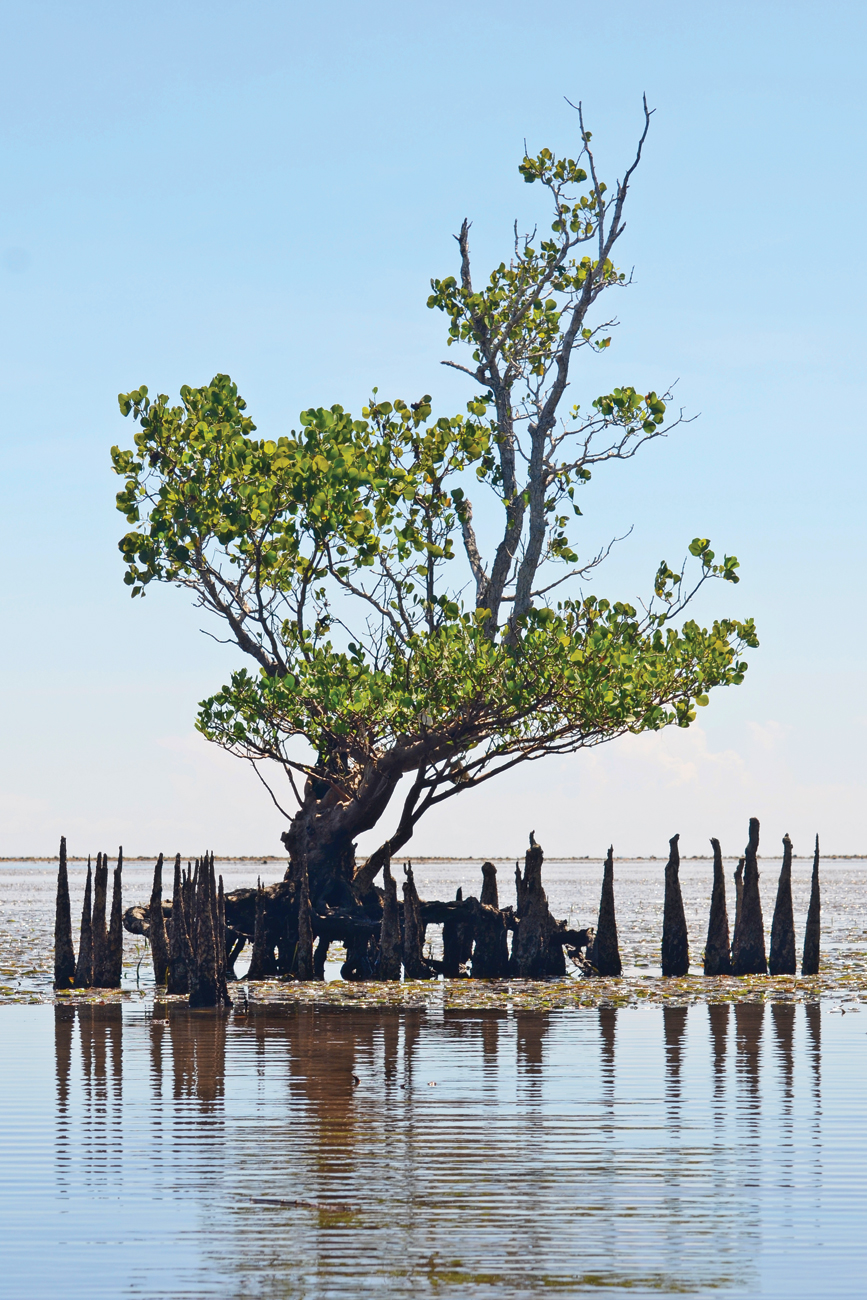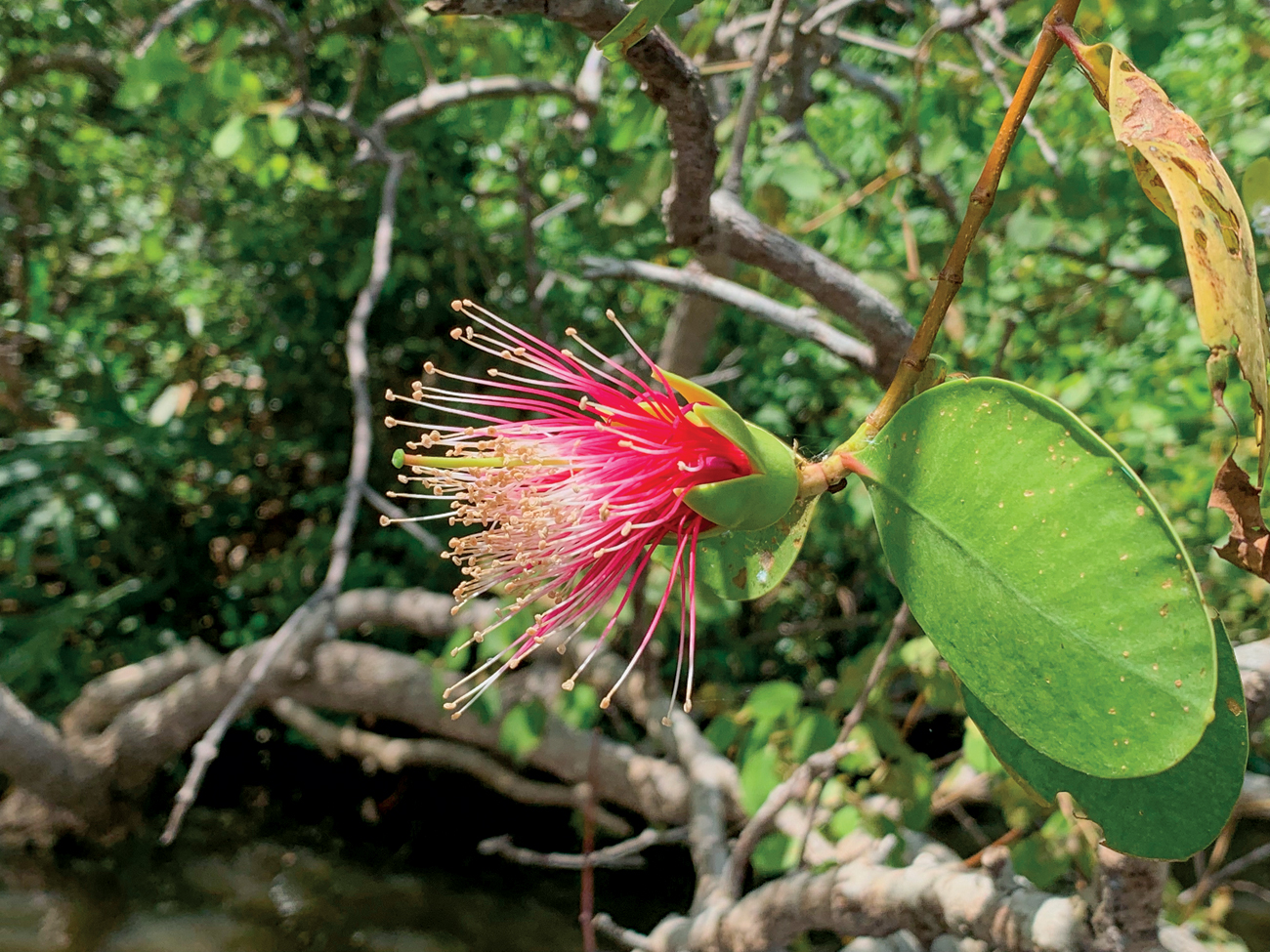Unseen Ecology
First published in Sanctuary Asia,
Vol. 45
No. 10,
October 2025
By Soham Kacker
In a quiet suburban garden, fireflies take to the sky at dusk, their intermittent signals imprinting bioluminescent morse code onto the humid tropical air. Faraway in the city, a fruit vendor sells summer delicacies: mangoes, bananas, coconuts, and more recent introductions from distant eastern shores – durians. While they may seem entirely disconnected, these two scenes are linked by the all-pervading web of unseen ecological exchanges and relationships that underpin all life around us. More specifically, both these scenes are made possible by a single tree – whose white-tipped neon-pink powder-puff flowers bob gently above the dark brackish water, stirred by the sea breeze. Meet the mangrove apple aka Sonneratia caseolaris, part discotheque, part diner, part hostel; an entirely underappreciated resident of coastal mangrove forests throughout tropical Asia.
On still, clear summer nights thousands of fireflies of the genus Pteroptyx gather on the branches of Sonneratia trees. Male fireflies flash their lights in synchrony, amplifying the effect of thousands of points of light to attract mates, in an increasingly rare phenomenon. For the fireflies, Sonneratia trees are preferred ‘display trees’, their wide-branching architecture, not-too-dense leaves, and proximity to water make them the perfect environment for firefly larvae to develop, and for adult fireflies to stage their magical nocturnal displays without being obscured by too much foliage. In coastal areas, these mangrove trees are one of the main habitats for fireflies, and sites with decreasing densities of these trees show an equal decrease in firefly numbers.

Along with its close relative Sonneratia alba, are commonly known as ‘mangrove apples’. Photo: Arief Rahman/CC-BY-SA-4.0.
The same open canopy architecture attracts another group of animals to these mangroves: bats. Adult Sonneratias are a favourite roost for many species of bats – the open canopies, which make firefly displays visible, also make it easier for bats to manoeuvre in and out of the branches. Several species of bats also feed on the fleshy fruits of the mangroves, and drink the nectar from the night-blooming flowers. As primary pollinators and seed dispersers of Sonneratia trees, bat activity is vital to ensuring the survival of Sonneratia populations and the fireflies that depend on them. The same bats that pollinate the mangroves also serve as the primary pollinators for several other fruit species, such as bananas, coconuts, durians, and even mangoes! The ability of bat species to travel further than other pollinators on average means that while they roost in mangroves, they play crucial roles in agro-ecosystems further inland too. Despite their important role in this ecological web, mangroves are rarely seen as bat habitat, occasionally overlooked even by ecologists owing to the little research that explores these interlinkages.

The brilliantly coloured yet delicate flower of Sonneratia caseolaris. Photo: Soham Kacker.
In coastal cities, Sonneratias are more than the sum of their many ecological connections. They are a coastal pioneer, stabilising disturbed soil and preventing erosion, and their roots are incredibly efficient at absorbing heavy metal pollutants, which leach out from urban and industrial wastewater, from the environment. Ultimately, by serving as a roost, respite, and resource for many plant and animal associates, they are at the centre of a web of connections that foster ecosystems and even help bring food to our plates. Yet increasing coastal development, the rapid loss of mangrove ecosystems both urban and otherwise, and a changing climate resulting in higher and harsher sea levels has led to a reduction in Sonneratia-dominated ecosystems across south and south-east Asia. The unseen ecology of these mangroves is likely to become tangible only when it begins to unravel – as fireflies become virtually absent from coastal cities, and many Asian countries face a pollination crisis that threatens food security. The silver lining is the Sonneratia itself – it propagates prolifically and grows robustly, meaning it will be quick to return, if we let it. And we must – since mangoes and the magic of summer evenings depend on it!
Further Reading
- Prasertkul, Tanthai. ‘Characteristics of Pteroptyx Firefly Congregations in a Human Dominated Habitat’. Journal of Insect Behavior 31, no. 4 (2018): 436–57. https://doi.org/10.1007/s10905-018-9687-8.
- Abu Seri, Nurhafizul, and Azimah Abd Rahman. ‘The Importance of Vegetation Landscape in Firefly Habitats’. Pertanika Journal of Science and Technology 32, no. 4 (2024): 1789–810. https://doi.org/10.47836/pjst.32.4.18.
- Thong, Vu Dinh, Annette Denzinger, Vu Long, et al. ‘Importance of Mangroves for Bat Research and Conservation: A Case Study from Vietnam’. Diversity 14, no. 4 (2022): 258. https://doi.org/10.3390/d14040258.
Soham Kacker is a plant ecologist and horticulturist from New Delhi. His research looks at plant conservation and ethnobotanical landscapes in the Indian Himalaya and beyond.



